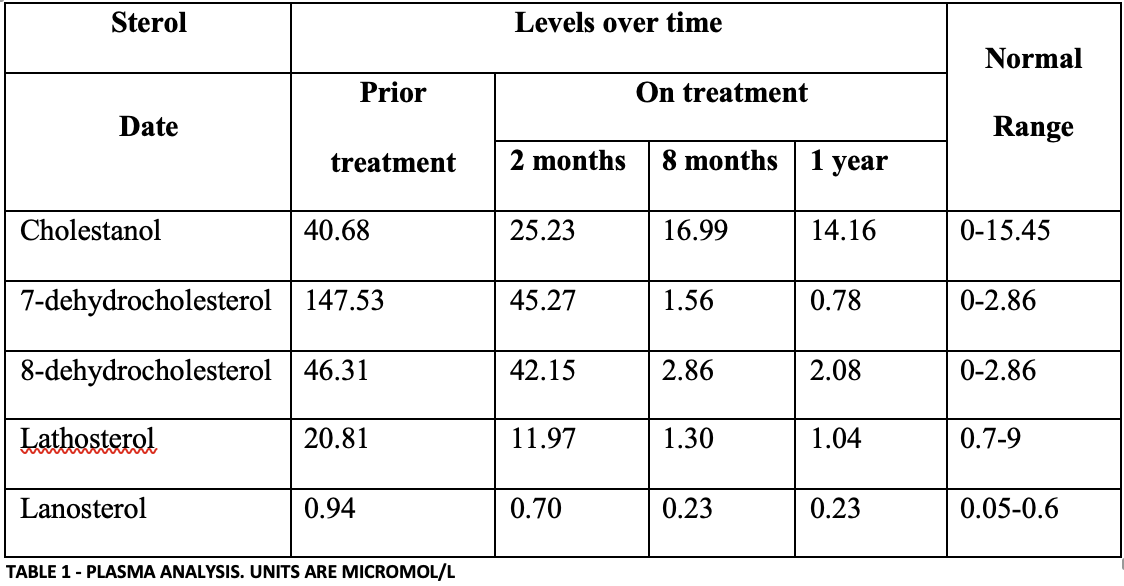Category: Rare Genetic and Metabolic Diseases
Objective: To describe a young male diagnosed with cerebrotendinous xanthomatosis who responded favourably to subthalamic nucleus deep brain stimulation (STN-DBS).
Background: Cerebrotendinous Xanthomatosis is an underdiagnosed, treatable multisystem disorder. An autosomal recessive pathogenic variant of the CYP27A1 gene results in altered bile acid metabolism. Features may be present from infancy. Movement disorders may manifest, of which parkinsonism is the most common. Chenodeoxycholic acid (CDCA)may reverse the condition, but parkinsonism does not respond to treatment.
Method: A gentleman presented with right arm tremor and stiffness at age 37. Tremor began in his twenties, leading to mobility issues with stiffness, jerks and gait freezing. Right-sided bradykinesia and bilateral cogwheel rigidity were present, and he was diagnosed with Parkinson Disease. Levodopa, rasagiline and ropinirole produced a good response. Motor complications eventually developed. DaT-SPECT scan showed decreased putaminal uptake. Genetic studies were negative. His speech, rigidity, bradykinesia, cognition and jerks worsened. Levodopa challenge demonstrated UPDRS-III scores of 76 and 42, OFF and ON treatment respectively. Given his young age and symptom severity, bilateral STN-DBS was performed when he was 42 years old. Motor fluctuations, rigidity and bradykinesia improved. ON medication ON stimulation UPDRS III was 31 at 6 months. DBS was switched off a year later, resulting in a rigid-akinetic state. Due to the atypical presentation, progression and age, more extensive genetic studies were done. Homozygous pathogenic variants in CYP27A1 was identified. Sterols in plasma demonstrated elevated cholestanol, 7- and 8-dehydrocholeserol, lathosterol and lanosterol (table 1).
Results: CDCA was titrated to 250mg 5 times daily. Current medication includes levodopa/carbidopa, ropinirole, CDCA, and low-dose benzodiazepines and citalopram for mood disorder. His clinical condition has stabilised, and he continues to benefit from DBS. Plasma cholestanol levels improved.
Conclusion: Early diagnosis, and treatment with CDCA, may prevent and reverse systemic and neurologic manifestations of CTX. This is the first report of a patient with CTX parkinsonism who demonstrated clinical benefit from STN DBS. DBS may provide patients with a neurosurgical treatment option for established parkinsonism in CTX.
References: 1. Cali JJ, Hsieh CL, Francke U, Russell DW. Mutations in the bile acid biosynthetic enzyme sterol 27-hydroxylase underlie cerebrotendinous xanthomatosis. J Biol Chem. 1991;266(12):7779–83.
2. Oftebro H, Bjorkhem I, Skrede S, Schreiner A, Pederson JI. Cerebrotendinous xanthomatosis. A defect in mitochondrial 26-hydroxylation required for normal biosynthesis of cholic acid. J Clin Invest. 1980;65(6):1418–30.
3. Duell PB, Salen G, Eichler FS, DeBarber AE, Connor SL, Casaday L, et al. Diagnosis, treatment, and clinical outcomes in 43 cases with cerebrotendinous xanthomatosis. J Clin Lipidol. 2018 Sep 1;12(5):1169–78.
4. Crestani M, Sadeghpour A, Stroup D, Galli G, Chiang JYL. Transcriptional activation of the cholesterol 7α-hydroxylase gene (CYP7A) by nuclear hormone receptors. J Lipid Res. 1998 Nov 1;39(11):2192–200.
5. Li T, Jahan A, Chiang JYL. Bile acids and cytokines inhibit the human cholesterol 7α-hydroxylase gene via the JNK/c-Jun pathway in human liver cells. Hepatology. 2006 Jun;43(6):1202–10.
6. Mignarri A, Gallus GN, Dotti MT, Federico A. A suspicion index for early diagnosis and treatment of cerebrotendinous xanthomatosis. J Inherit Metab Dis [Internet]. 2014 May 18 [cited 2020 Apr 8];37(3):421–9. Available from: http://doi.wiley.com/10.1007/s10545-013-9674-3
7. Salen G, Steiner RD. Epidemiology, diagnosis, and treatment of cerebrotendinous xanthomatosis (CTX) [Internet]. Vol. 40, Journal of Inherited Metabolic Disease. Springer Netherlands; 2017 [cited 2020 Apr 8]. p. 771–81. Available from: http://www.ncbi.nlm.nih.gov/pubmed/28980151
8. Raymond G V., Schiffmann R. Cerebrotendinous xanthomatosis: The rare “treatable” disease you never consider. Neurology. 2019;92(2):61–2.
9. Berginer VM, Salen G, Patel SB. Cerebrotendinous Xanthomatosis. In: Rosenberg’s molecular and genetic basis of neurological and psychiatric disease. Elsevier Ltd; 2015. p. 589–98.
10. Stelten BML, Huidekoper HH, Van De Warrenburg BPC, Brilstra EH, Hollak CEM, Haak HR, et al. Long-term treatment effect in cerebrotendinous xanthomatosis depends on age at treatment start. Neurology. 2019 Jan 8;92(2):E83–95.
11. Stelten BML, van de Warrenburg BPC, Wevers RA, Verrips A. Movement disorders in cerebrotendinous xanthomatosis. Park Relat Disord [Internet]. 2019;58(July 2018):12–6. Available from: https://doi.org/10.1016/j.parkreldis.2018.07.006
To cite this abstract in AMA style:
R. Tilney, N. Dingli, E. Said, L. Zrinzo, J. Aquilina. Adult onset cerebrotendinous xanthomatosis (CTX) with parkinsonism responding to bilateral subthalamic nucleus deep brain stimulation [abstract]. Mov Disord. 2023; 38 (suppl 1). https://www.mdsabstracts.org/abstract/adult-onset-cerebrotendinous-xanthomatosis-ctx-with-parkinsonism-responding-to-bilateral-subthalamic-nucleus-deep-brain-stimulation/. Accessed December 27, 2025.« Back to 2023 International Congress
MDS Abstracts - https://www.mdsabstracts.org/abstract/adult-onset-cerebrotendinous-xanthomatosis-ctx-with-parkinsonism-responding-to-bilateral-subthalamic-nucleus-deep-brain-stimulation/

